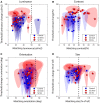Visual surround suppression in schizophrenia
- PMID: 23450069
- PMCID: PMC3584288
- DOI: 10.3389/fpsyg.2013.00088
Visual surround suppression in schizophrenia
Erratum in
-
Corrigendum: Visual surround suppression in schizophrenia.Front Psychol. 2019 Aug 22;10:1898. doi: 10.3389/fpsyg.2019.01898. eCollection 2019. Front Psychol. 2019. PMID: 31485211 Free PMC article.
Abstract
Compared to unaffected observers patients with schizophrenia (SZ) show characteristic differences in visual perception, including a reduced susceptibility to the influence of context on judgments of contrast - a manifestation of weaker surround suppression (SS). To examine the generality of this phenomenon we measured the ability of 24 individuals with SZ to judge the luminance, contrast, orientation, and size of targets embedded in contextual surrounds that would typically influence the target's appearance. Individuals with SZ demonstrated weaker SS compared to matched controls for stimuli defined by contrast or size, but not for those defined by luminance or orientation. As perceived luminance is thought to be regulated at the earliest stages of visual processing our findings are consistent with a suppression deficit that is predominantly cortical in origin. In addition, we propose that preserved orientation SS in SZ may reflect the sparing of broadly tuned mechanisms of suppression. We attempt to reconcile these data with findings from previous studies.
Keywords: contrast; cortex; luminance; orientation; perception; schizophrenia; size; surround suppression.
Figures




References
Grants and funding
LinkOut - more resources
Full Text Sources
Other Literature Sources
Research Materials

